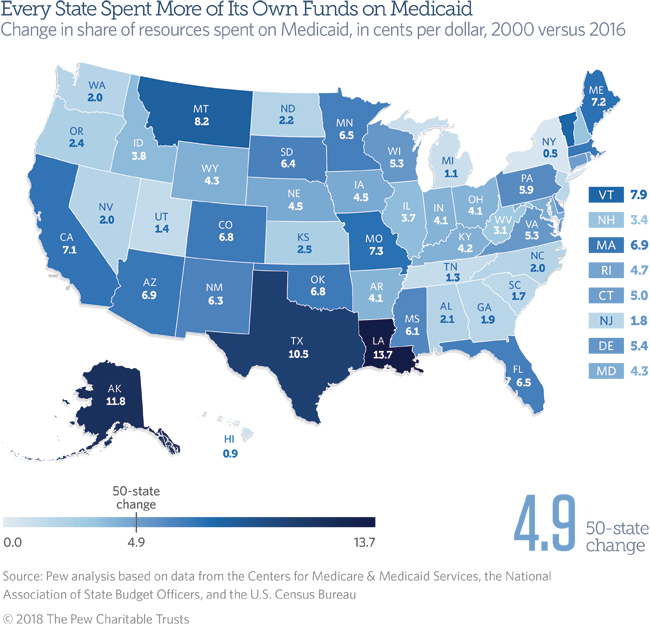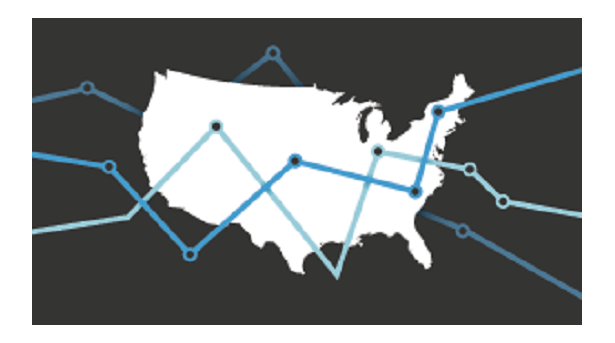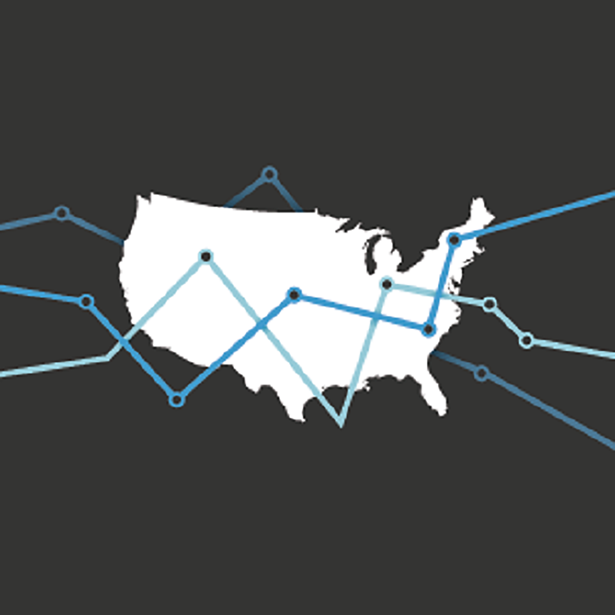More Than 17 Cents of Each State Revenue Dollar Goes to Medicaid
These data have been updated. For the latest information, visit Fiscal 50: State Trends and Analysis.
A post-recession spike in the portion of states’ own money spent on Medicaid health care coverage for low-income Americans persisted in fiscal year 2016. Nationwide, Medicaid consumed 17.1 cents of every state-generated dollar that year, 4.9 cents more per dollar than in fiscal 2000 and the largest percentage since that year.
Every state spent a larger share of its own dollars on Medicaid in 2016 than in 2000, and percentages in 18 states reached a new high. The increases varied widely, however, from less than 1 cent more per state-generated dollar in Hawaii and New York to nearly 14 cents more in Louisiana.
Medicaid is most states’ biggest expense after K-12 education. States and the federal government share costs for the safety-net program, which provides medical coverage for eligible groups of children, adults, people with disabilities, and the elderly.
The costs borne by states surged in the wake of the Great Recession, after the expiration of federal economic stimulus dollars that had helped cover a spike in Medicaid enrollment during the downturn. As a share of own-source revenue, states’ collective costs have plateaued at roughly 17 cents of each revenue dollar since 2012, even with the Affordable Care Act’s (ACA) optional expansion of Medicaid coverage beginning in 2014. Costs for newly eligible low-income adults were fully reimbursed by the federal government in the 31 states that chose to expand their Medicaid programs through 2016.
This state Medicaid spending indicator excludes federal support, examining only the cost to states because that spending—and increases relative to revenue—exerts pressure on their operating budgets, which rely on state-generated revenue.
Medicaid’s claim on each revenue dollar affects the share of state resources available for other priorities, such as education, transportation, and public safety. Because Medicaid is an entitlement program, states must provide certain federally required benefits for any eligible enrollee, even during times of sluggish revenue growth. So policymakers have less control over growth in states’ Medicaid costs than they do with many other programs.
State highlights
A comparison of states’ Medicaid spending relative to their own resources in 2000 and 2016 shows:
- Louisiana’s share rose the most since 2000. In 2016, the state spent 24.3 percent of its own revenue on Medicaid, 13.7 percentage points higher than in 2000—equivalent to 13.7 cents more of each state-generated dollar.
- The next-largest hikes per revenue dollar were in Alaska (11.8 cents) and Texas (10.5 cents). These three states were the only ones with increases of more than 10 cents per state-generated dollar.
- The slowest growth was in five states with increases of 1.5 cents or less per own-source dollar: New York (0.5), Hawaii (0.9), Michigan (1.1), Tennessee (1.3), and Utah (1.4).
- The 18 states where Medicaid in 2016 was at its highest level since 2000 were Alaska, Colorado, Florida, Iowa, Kentucky, Louisiana, Massachusetts, Mississippi, Montana, Nebraska, New Mexico, North Dakota, Oklahoma, South Dakota, Texas, Vermont, Virginia, and Wyoming. Participation in the optional Medicaid expansion was split almost evenly among this group, with 10 participating as of 2016 and eight not. Virginia elected to expand in June 2018.
- Eight states spent more than one-fifth of their own revenue on Medicaid in 2016: New York (27.0 percent), Louisiana (24.3 percent), Rhode Island (23.1 percent), Pennsylvania (21.9 percent), Massachusetts (21.8 percent), Texas (21.8 percent), Missouri (21.7 percent), and Tennessee (20.2 percent). New York spent the largest share of its own revenue on Medicaid in every year of the study period. Texas joined this group for the first time since at least 2000.
- The states that spent the lowest share of own dollars on Medicaid in 2016 were Utah (5.8 percent), Hawaii (8.1 percent), Nevada (9.1 percent), North Dakota (9.4 percent), and Wyoming (9.9 percent).
Trend drivers
States in 2016 collectively spent $220.4 billion of their own resources to provide health benefits for eligible low-income Americans. This was $8.8 billion more than in 2015, a 4 percent rise—the second-slowest annual rate in six years. Because state revenue rose even more slowly (2.0 percent), the slice of state dollars devoted to Medicaid coverage expanded from 16.8 percent in 2015 to 17.1 percent in 2016.
Higher enrollment has been one of the major drivers of growth in Medicaid spending, with more than twice as many people enrolled in 2016 than in 2000. From 2000 to 2013, a number of factors drove up enrollment, including two economic downturns—which caused people to lose jobs and associated health insurance—and a gradual erosion of employer-sponsored insurance. From 2014 to 2016, millions more joined the program as the optional expansion under the ACA was implemented by 31 states, but the federal government agreed to absorb the first three years of all related expenses for newly eligible enrollees. Future enrollment growth could be curbed because of low unemployment and federally approved actions by some states to require work or other community engagement as a condition of eligibility for certain adults.
Influence of federal policy changes
Medicaid is a state-administered program, but the federal government covered from 50 to 78 percent of states’ bills for the program in 2016, for a total of 62.1 percent of costs. Spending by the federal government on Medicaid rose 5 percent that year, from $344.2 billion in 2015 to $360.5 billion.
Changes in federal policies have helped shape states’ financial responsibilities for Medicaid. Most recently, the ACA provided an opportunity for states to expand their programs with enhanced federal support. The latest 50-state data reflect nearly three years—11 quarters—of the ACA’s Medicaid expansion, which took effect in January 2014. The law expanded Medicaid eligibility to all adults under age 65 who earn up to 138 percent of the federal poverty level, a change that the U.S. Supreme Court later ruled was optional for states. The U.S. government agreed to reimburse 100 percent of expansion costs through 2016 for states that chose to extend health coverage to newly eligible low-income adults, dropping to 95 percent in 2017 and ultimately to 90 percent by 2020. As of the federal fiscal year ending Sept. 30, 2016, the timeframe for this analysis, 31 states had expanded their programs in accordance with the ACA, with Louisiana and Montana participating for part of the fiscal year. As of June 2018, 33 states had agreed to expand eligibility for Medicaid, though Maine and Virginia, the most recent adopters, had not started implementation.
In response to the 2001 and 2007-09 recessions, as state tax revenue fell, the federal government sent extra dollars to states to help cover the increased costs associated with higher Medicaid enrollment. When enhanced federal aid from the Great Recession tapered off between December 2010 and June 2011, states’ share of the costs spiked while their tax revenue was still recovering.
In 2006, the federal government began relieving states of prescription drug costs for “dual eligibles,” people who qualify for both Medicaid and the federal Medicare program. In return, states are required to share some of their savings with the federal government through annual “clawback” payments, which are included in this analysis as part of state Medicaid spending.
The proportion of federal reimbursement that states receive is one of several factors that influence the wide range in the share of their own revenue spent on Medicaid. This variation is attributable not only to state Medicaid policy decisions—the breadth of health care services covered, eligible populations, and provider payment rates—but also to tax and other policy decisions that determine state revenue. Variation also is driven by factors outside of policymakers’ direct control, such as state economic performance, demographics, resident health status, and regional differences in health care costs and practices. (For more information, see “State Health Care Spending on Medicaid.”)
Download the data to see individual states’ Medicaid spending as a share of own-source revenue for each fiscal year from 2000 to 2016. Visit Pew’s interactive resource Fiscal 50: State Trends and Analysis to sort and analyze data for other indicators of state fiscal health.















